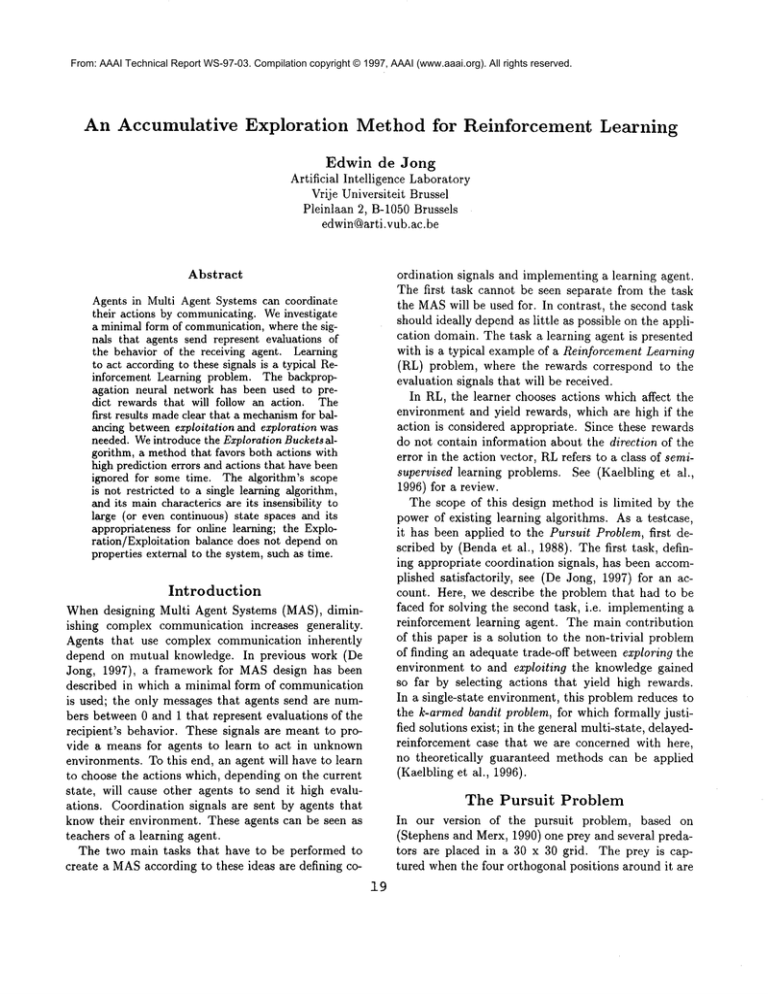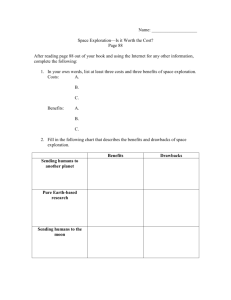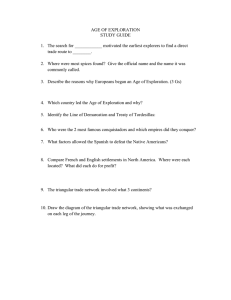
From: AAAI Technical Report WS-97-03. Compilation copyright © 1997, AAAI (www.aaai.org). All rights reserved.
An Accumulative
Exploration
Method for Reinforcement
Learning
Edwin de Jong
Artificial Intelligence Laboratory
Vrije Universiteit Brussel
Pleinlaan 2, B-1050Brussels
edwin@arti.vub.ac.be
Abstract
ordination signals and implementing a learning agent.
The first task cannot be seen separate from the task
the MASwill be used for. In contrast, the second task
should ideally dependas little as possible on the application domain. The task a learning agent is presented
with is a typical example of a Reinforcement Learning
(RL) problem, where the rewards correspond to the
evaluation signals that will be received.
In RL, the learner chooses actions which affect the
environment and yield rewards, which are high if the
action is considered appropriate. Since these rewards
do not contain information about the direction of the
error in the action vector, RLrefers to a class of semisupervised learning problems. See (Kaelbling et al.,
1996) for a review.
The scope of this design method is limited by the
power of existing learning algorithms. As a testcase,
it has been applied to the Pursuit Problem, first described by (Benda et al., 1988). The first task, defining appropriate coordination signals, has been accomplished satisfactorily,
see (De Jong, 1997) for an account. Here, we describe the problem that had to be
faced for solving the second task, i.e. implementing a
reinforcement learning agent. The main contribution
of this paper is a solution to the non-trivial problem
of finding an adequate trade-off between exploring the
environment to and exploiting the knowledge gained
so far by selecting actions that yield high rewards.
In a single-state environment, this problem reduces to
the k-armed bandit problem, for which formally justified solutions exist; in the general multi-state, delayedreinforcement case that we are concerned with here,
no theoretically
guaranteed methods can be applied
(Kaelbling et al., 1996).
Agents in Multi Agent Systems can coordinate
their actions by communicating.Weinvestigate
a minimalform of communication,where the signals that agents send represent evaluations of
the behavior of the receiving agent. Learning
to act accordingto these signals is a typical Reinforcement Learning problem. The backpropagation neural network has been used to predict rewards that will follow an action. The
first results madeclear that a mechanism
for balmacingbetween exploitation and exploration was
needed. Weintroduce the Exploration Buckets algorithm, a methodthat favors both actions with
high prediction errors and actions that have been
ignored for some time. The algorithm’s scope
is not restricted to a single learning algorithm,
madits maincharacterics are its insensibility to
large (or even continuous) state spaces and its
appropriateness for online learning; the Exploration/Exploitation balance does not depend on
properties external to the system, such as time.
Introduction
When designing Multi Agent Systems (MAS), diminishing complex communication increases generality.
Agents that use complex communication inherently
depend on mutual knowledge. In previous work (De
Jong, 1997), a framework for MASdesign has been
described in which a minimal form of communication
is used; the only messages that agents send are numbers between 0 and 1 that represent evaluations of the
recipient’s behavior. These signals are meant to provide a means for agents to learn to act in unknown
environments. To this end, an agent will have to learn
to choose the actions which, depending on the current
state, will cause other agents to send it high evaluations. Coordination signals are sent by agents that
know their environment. These agents can be seen as
teachers of a learning agent.
The two main tasks that have to be performed to
create a MASaccording to these ideas are defining co-
The Pursuit
Problem
In our version of the pursuit problem, based on
(Stephens and Merx, 1990) one prey and several predators are placed in a 30 x 30 grid. The prey is captured when the four orthogonal positions around it are
19
occupied by predators. Weuse Stephens and Merx’s
efficiency measures. The prey selects its actions by
randomly choosing between moving left, right, up or
down,and staying at the current position, but does not
consider any occupied positions. In the experiments
described here, the minimumnumber of 4 predators
is used. Three of these predators send coordination
signals to their two neighbours, which represent evaluations of their coordination with these neighbours.
The fourth predator is a learning agent. Since neighbours are determined by comparing angles with the
prey, the learning agent will normally receive two coordination signals; one from both neighbours. In exceptional cases, when several predators have the same
angle (but different distances) to the prey, the learning agent may receive a different number of signals.
A learning agent interprets the average of the incoming signals as its reward. This setup contrast with the
more commonlyused environmental rewards, and provides a way for agents to put learning agents to their
use. The coordination signals are computed as follows:
signal
=
¢opt
Eval(Ap, Aq)
0.04. (1
Eval(A2, A1) + Eval(A3,
2re
#predators
= 0.96.
_
(1 Ap.d+
Aq.d)
+
I¢opt - ((Ap.phi - Aq.phi)
mod2~r)l
)
Ema~
ETr¢ aX
where d is the distance to the prey, ¢ the angle between two predators and Emax the maximal error in
this angle.
Finding
a Suitable
Reinforcement
Learning
Algorithm
A commonalgorithm for reinforcement learning problems is Q-learning (Watkins, 1989). This technique
found its way into the domain of multi agent systems,
see e.g. (Sen and Sekaran, 1995), (Sandholm
Crites, 1995). Q-learning involves storing valuations
for each possible action in every state. This is only feasible in problems with a small numberof possible states
and actions. For the problem at hand, the inputs consist of the polar coordinates of all predators relative to
the prey, and the cartesian coordinates of the prey. Although the number of possible actions is only 5 (moving in the compass directions and staying), the number
of combinations of state and action already amounts to
2O
10151 To avoid this combinatorial
5 ~ 900!
/ = 2.9.
explosion, several methods for generalization exist. In
(Sutton, 1996), a function approximator is applied
discretize a continuous state space, so that algorithms
based on storing information about combinations of
actions and states can be used all the same. Another
approach to generalization is to use neural networks
that interpolate between states situations (and possibly, but not in our case, actions). Of the manyneural
network architectures that are described in the literature, quite a lot use binary-valued rewards. Since
the succes of a predator that bases its actions on the
coordination signals depends quite critically on small
differences in these values, binary rewards are not sufficient here. A possible solution to this would be to
train the network on differences between subsequent
rewards; increases can then be used as good rewards
(1), and decreases as bad ones (0). This scheme is
investigated here, since its assumptions (i.e. a good
action will always result in an increase of the reward)
makeit less generally applicable.
As a learning algorithm, we use the commonbackpropagation network, see (Rumelhart et al., 1987).
The inputs are the polar positions of all predators (including the learning agent) and the cartesian position
of the prey, and a bias input neuron. The network
has one hidden layer of 20 neurons. The output layer
contains 5 neurons, each representing an action. Each
output neuron should learn to predict the reward its
corresponding action would return on execution. Only
the neuron corresponding to the action that was executed changes its weights to learn the received reward. The learning agent was designed to be used
in the abovementioned framework for coordination in
multi agent systems. The goals of this framework include that the learning agent should in principle be
independent from the application domain. As a consequence, the intervals within wich the values of the
inputs may vary are unknownduring the construction
of the network. The problem of scaling the input values is handled by computing the mean and variance of
each input as if its values were normally distributed.
Inputs within [/~ - 2 ¯ ~r..# + 2 ¯ or] are linearly scaled
and translated to fit within [0..1]; inputs outside this
interval are replaced by the scaled and translated value
of their nearest bound.
1This is the numberof actions (4 directions + resting)
multiplied by the numberof ways in which the 5 recognizably different agents (the agent, the prey and the 3 other
predators) can be placed on the 30 x 30 grid.
The
Exploration
Buckets
Algorithm
Actions
One thing all RL algorithms have in commonis the
need for a strategy that defines when to explore and
when to exploit. The motivation for an agent to learn
is to be able to exploit the knowledge it gradually
builds up to choose actions that yield high rewards.
But when no attention is paid to exploring actions
with lower expectated rewards, underrated actions will
never be recognized as such. The task of an Exploration / Exploition algorithm is to find a good balance
between these. According to (Thrun, 1992), exploration mechanisms can be divided into undirected and
directed strategies. Within the class of directed strategies, which are generally more successful than undirected ones such as random or stochastic exploration,
three types are encountered: stategies based on counters, on recency and on errors. Weare interested in
finding an exploration mechanism that possesses the
following properties:
G
G
©
Explorationbuckets
+
+
+
XA
~/
XB
~
/
~7
+
+
Eligibilities
~/
~
=
X
C
=
X
D
=
X
E
Figure 1: Exploration buckets
Many approaches to exploration feature some of
these requirements, but none was encountered that
satisfies all. (Sutton, 1990)~ introduces exploration
bonuses that keep a memoryfor each state x and each
action a of" the numberof time steps that have elapsed
since a was tried in x in a real experience". This interesting recency-based strategy is restricted to problems
with small numbers of states and actions. In (Cohn,
1994), an algorithm based on Federov’s Theory of Optimal Experiment Design, see (Federov, 1972), is described. This algorithm can be very useful for choosing expensive experiments, such as drilling oil wells,
but will generally be too slow for online learning. In
(Dayan and Sejnowski, 1996), an estimation of the
Bayesian balance between exploration and exploitation
is computed. This method is limited to systems that
keep a model of state transitions.
Weintroduce the
Exploration Buckets algorithm, which meets all of the
above requirements. The exploration bucket of action
k is updated as follows, assuming action i was chosen:
¯ It can be used for online learning
(Thrun, 1992) describes several algorithms that distinguish between the learning phase and the performing phase. As (Sutton, 1993) notes, in order
to obtain learning systems instead of merely learned
ones, online learning is required. This refers to learning that is done during the operational phase of a
system. Online learning agents that have to operate in a changing environment should never stop
learning, and should therefore avoid to distinguish
between learning and operating phases. (Wilson,
1996) gives a systematic account of the variables on
which the balance between exploration and exploitation maydepend. Similarly, dependency of this balance on the running time is to be avoided when
designing an online learning agent. This excludes
the popular exploration mechanisms that depend on
the slowly decaying influence of randomness , such
as Gullapalli’s SRVunit (Gullapalli, 1990), which
implements exploration by adding random numbers
from a zero-mean Gaussian distribution
to a neuron’s output and gradually decreasing the variance
of this distribution over time. A further requirement
for an online learning agent is limited computational
complexity.
fork
= i:
B~+ I = 0
Ekt+l
= Ipredicted
I
fork 7£ i:
reward - actual reward
i~
¯ It is not restricted to small problems
As we saw before, even an apparently simple domain
such as the pursuit problem may lead to forbiddingly
large search memoryrequirements when all combinations of states and actions are seen as separate. Exploration mechanisms that depend on storing values
for each such combination therefore cannot be used
without substantial changes.
E
+ 0.1. ,%1)
B~+I= B~+ a. <O’~’Ek
=
where Bk is the content of the exploration bucket of
action k, and Ek the error between real and predicted
reward when action k was last executed. The exploration bucket of the chosen action is emptied. Its con-
21
tent is not transferred to other buckets. The buckets of
the other actions are increased by a value proportional
to the error in the prediction of the reward when that
action was last selected. The average previous error
of all actions, multiplied by a small factor, is added
to this to ensure exploration of all actions when the
general performance is decreasing due to a changed
environment. In all experiments reported on here the
influence of the exploration bonuses, ~, was 1. The
eligibility of an action is the sumof its predicted reward and its exploration bucket. The action with the
highest eligibility is selected for execution. The resulting behaviour is that exploration is stimulated by these
two aspects:
t
o.0
0,6
0.4
0,2
0
-0.2
-0.n f
-O.6
-0.0
-1
30000 30050 30100 30150 302OO 30250 30300 30350 30400 30450 30500
¯ the last time the action was taken, the prediction
of the corresponding reward was not very precise
(error-based)
¯ the action has not been tried
(recency-based)
for a long time
Figure 2: Upper two lines: network’s prediction and
real reward as a function of, the number of moves.
Lower line: error. The network has learned to predict
the rewards it will receive quite accurately.
The effect of accumulating exploration bonuses is that
even an action with small bonuses will eventually be
selected. In environments where the rewards are highly
stochastic, it can be foreseen the algorithm will keep
exploring when no more benefit is to be gained. Since
the exploration mechanism avoids storing information
(such as the unpredictability of rewards) about particular states, a solution to this is not obvious. An
important property of this exploration policy is that it
does not depend on quantities external to the system,
such as time.
5
LmFt -Right
........
Up-Down
.......
Sta~
4.5
4
3.5
Results
3
2.5
Qualitatively, the results of the learning algorithm can
be described as follows. At the beginning, all weights
of the network are random; some actions are consequently estimated to yield high returns, and others
low returns. Since these predictions are initially random, the high errors result in high exploration bonuses
and hence much exploration. As a result of this exploration, the predictions soon converge to a situation
where all actions yield predictions approaching the average reward. Then the agent learns to distinguish
more subtle differences in the environment, resulting
in more accurate predictions. Finally, enough detail
is reached to distinguish between the rewards of the
different actions in a situation. This is particular to
the definition of the rewards. Since the evaluation
of the learning agent’s behavior is done by continually judging the current state, not its action, the rewards are strongly correlated to the previous reward,
and only implicitly depend on the chosen action. The
very small differences in returns that are the effect of
2
1.5
1
0.5
~
0
5O
100
150
200
250
300
350
400
450
500
Figure 3: Exploration bonuses of the 5 actions peak
when the network makes large errors in its predictions
(see figure 4). The oscillating exploration value between 150 and 300 solves the low initial predictions of
’moving left’. The high prediction errors quickly fill
this action’s exploration bucket, thus causing the system to select the action frequently and learn its real
value. Later on (not shown), the influence of exploration drops.
22
LeFt -RightUpD
Down --
O.B
Exploration
Buckets-Raul6tre
.......
Expiorstzon
Buckets-Roulette
.......
0.6
0.4
.
0.2
/:.).
.)~
r "~/v,/:
I
......
:.~.
......
:-~:
......._........
.7.
....
.......
. .........
."~::
.......
........
........
................
~? ¯ :..,’:~..~
......
.,_f 1oo
50
100
150
200
250
300
350
400
450
500
Figure 4: Exploration sees to it that the initial low
predictions of action ’moveleft’ are quickly increased.
200
300
400
5oo
6oo
zoo
Figure 5: Resulting efficiencies of the pursuit problems.
The topmost and the lower middle line are the efficiencies of the Exploration Buckets network, the other
two lines are the same 2 efficiencies for Roulette exploration.
this makethis learning problem a rather difficult one.
These first experiences with the Exploration Buckets
algorithm show that it performed better than Roulette
exploration, see (Goldberg, 1989), which was used as
comparison. With Roulette exploration, the outputs of
the network are used as relative probabilities to choose
the corresponding action. Using a delayed rewards algorithm, see (Sutton, 1988), could improve this. The
network using the Exploration Buckets algorithm that
has been presented can thus successfully be used for
finding a balance between exploration and exploitation for reinforcement learning problems with direct
rewards.
¯ It assures that actions with bad reward predictions
are selected frequently so they can as to improve
their predictions; meanwhileit has a minor influence
on exploitation once the agent has learned its environment; these are results of the error-dependence of
the method. The use of buckets that retain exploration bonuses when actions are not selected yields
the recency-based character of the algorithm. In future work, we plan to combine the exploration buckets algorithm with other learning methods and compare the resulting system to other explore/exploit
strategies.
Conclusions
Weinvestigated the possibilities for exploration in a
particular a reinforcement learning problem. The Exploration Buckets algorithm was introduced. The algorithm was tested by applying it in a network for an
agent that has to learn to become a predator in the
Pursuit Problem. The results were positive, and have
been comparedto the ’Roulette’ strategy. A limitation
is its inappropriateness for highly stochastic environments. Attractive properties of the method are:
¯ The balance between exploration and exploitation
does not change as a function of properties external
to the system, such as time. This is essential when
designing agents that have to operate in changing
environments.
Acknowledgments
The author wants to thank Walter van de Velde for
valuable suggestions and Bart de Boer for reading and
commenting on an earlier version. This research was
partially funded by EU Telematics Information Engineering
projects
MAGICAand GEOMED.GEOMED
(IE 2037) stands for ’Geographical mediation systems’.
MAGICA
(IE 2069) stands for ’Multi-Media Agentbased Interactive Catalogs’. Additional funding has
been provided by the OZRcontract for research on
models for coordination and competition in multi agent
systems.
¯ The time complexity is low. The space complexity
is linear in the number of actions, and independent
of the numberof possible states, also resulting in a
low complexity for the problem at hand.
References
Benda, M., Jagannathan, V., and Dodhiawalla, R. (1988).
On optimal cooperation of knowledgesources. Technical
Report BCS-G2010-28,Boeing AI Center.
23
Cohn, D. A. (1994). Neural network exploration
timal experiment design. Technical Report AI
and CBCLPaper 99, MIT A[ Lab and Center for
cal and Computational Learning Department of
Cognitive Sciences.
using opMemo1491
BiologiBrain and
Wilson, S. W. (1996). Explore / exploit strategies in autonomy. In et.al., P. M., editor, Proceedings of the fourth
international conference on simulation of adaptive behavior. From animals to animats 4. The MIT Press.
Dayan, P. and Sejnowski, T. J. (1996). Exploration
bonuses and dual control. Machine Learning, 25.
De Jong, E. D. (1997). Multi-agent coordination by communication of evaluations. In Proceedings of Modeling Autonomous Agents in a Multi Agent World MAAMAW
’97.
Federov, V. (1972). Theory of Optimal Experiments. Academic Press, NewYork.
Goldberg, D. E. (1989). Genetic Algorithms in Search,
Optimization, and Machine Learning. Addison-Wesley.
Gullapalli, V. (1990). A stochastic reinforcement algorithm for learning real-valued functions. Neural Netw.,
3:671-692.
Kaelbling, L. P., Littman, M. L., and Moore, A. W.
(1996). Reinforcement learning: A survey. Journal of
Artificial Intelligence Research, 4.
Rumelhart, D., McClelland, J., and et. al. (1987). Parallel
distributed processing; explorations in the microstructure
of cognition, volume 1-2. MITPress.
Sandholm, T. W. and Crites, R. H. (1995). On multiagent q-learning in a semi-competitive domain. In G. Weiss,
S. S., editor, Adaption and Learning in multi-agent systems, pages 191-205, Berlin, Heidelberg. Springer Verlag.
Sen, S. and Sekaran, M. (1995). Multiagent coordination
with learning classifier systems. In G. Weiss, S. S., editor,
Adaption and Learning in multi-agent systems, pages 218233, Berlin, Heidelberg. Springer Verlag.
Stephens, L. M. and Merx, M. B. (1990). The effect
agent control strategy on the performance of a dai pursuit problem. In Proceedings of the 1990 Distributed AI
Workshop.
Sutton, R. S. (1988). Learning to predict by the methods of temporal differences. Technical Report TR87-509.1,
GTELaboratories.
Sutton, R. S. (1990). Integrated architectures for learning,
planning, and reacting based on approximating dynamic
programming. In Proceedings of the Seventh lnt. Conf. on
Machince Learning, pp. 314-321, pages 216-224. Morgan
Kaufmann.
Sutton, R. S. (1993). Online learning with random representations.
In Proceedings of the Tenth Int. Conf. on
Machince Learning, pp. 314-321 , pages 314-321. Morgan
Kaufmann.
Sutton, R. S. (1996). Generalization in reinforcement
learning: Successful examples using sparse coarse coding. Advances in Neural Information Processing Systems,
8:1038-1044.
Thrun, S. (1992). The role of exploration in learning control. Van Nostrand Reinhold.
Watkins, C. (1989). Learning from delayed rewards. Ph.D.
Thesis.
24




